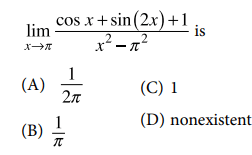CONTINUITY AND DIFFERENTIABILITY PROBLEMS FOR AP CALCULUS AB
Subscribe to our ▶️ YouTube channel 🔴 for the latest videos, updates, and tips.
Subscribe to our ▶️ YouTube channel 🔴 for the latest videos, updates, and tips.
Problem 1 :
Let f be the function such that
I. f is continuous at x = 4.
II f is differentiable at x = 4.
III. The derivative of f' is continuous at x = 4.
A) I only B) II only C) I and II only D) I, II and III only
Solution :
The given should be considered as derivative of f(x) at x = 4, since it exists, it is continuous and differentiable at x = 4.
From here we cannot decide anything about the derivative of f'(x), so the answer is I and II only.
Problem 2 :

Solution :
Using l'hopital rule,
Problem 3 :

Solution :
Problem 4 :

The graph of the piecewise defined function f is shown in the figure above. The graph has a vertical tangent line at x = -2 and horizontal lines x = -3 and x = -1 What are all values of x, -4 < x < 3 at which f is continuous but not differentiable ?
A) x = 1 B) x = -2 and x = 0 C) x = -2 and x = 1
D) x = 0 and x = 1
Solution :
Option A:
At x = 1, the function is continuous.
Option B:
At x = -2, the function is continuous but at x = 0, the function is not continuous.
Option C :
At vertical tangent line, at the points where it is discontinuous and at sharp edges or cusp, the function is not differentiable.
At x = -2, we draw the vertical tangent line. So, at x = -2 the function is not differentiable. At x - 1, we have a sharp edge.
At these two points the function is not differentiable. So, option C is correct.
Problem 5 :

A) I only B) II only C) I and II only D) I, II and III
Solution :
I
II
III
So, option B II is correct.
Problem 6 :

A) ln 2 B) ln 8 C) ln 16 D) 4 E) Non existent
Solution :
lim x->2- f(x) = lim x->2- ln x
= ln (2) --------(1)
lim x->2+ f(x) = lim x->2+ x2ln x
= 4ln (2) --------(2)
(1) ≠ (2)
So, the limit does not exists.
Problem 7 :
A particle moves along the x-axis so it s position at time t is given by
x(t) = t2 - 6t + 5
For what value of t is the velocity of the particle zero ?
Solution :
x(t) = t2 - 6t + 5
x'(t) = 2t - 6
v(t) = 2t - 6
Velocity = 0
2t - 6 = 0
t = 3
Problem 8 :
Let be the function defined by
Which of the following statements is true?
A) has a discontinuity due to a vertical asymptote at x = 0 and at x = 4 .
B) has a removable discontinuity at x = 0 and a jump discontinuity at x = 4
C) has a removable discontinuity at x = 0 and a discontinuity due to a vertical asymptote at x = 4
D) is continuous at x = 0, and has a discontinuity due to a vertical asymptote at x = 4.
Solution :
The common factor is x, then it has removable discontinuity at x = 0 and at x = 4, we have vertical asymptote.
So, the answer is C.
Recent Articles
-
Finding Range of Values Inequality Problems
May 21, 24 08:51 PM
Finding Range of Values Inequality Problems -
Solving Two Step Inequality Word Problems
May 21, 24 08:51 AM
Solving Two Step Inequality Word Problems -
Exponential Function Context and Data Modeling
May 20, 24 10:45 PM
Exponential Function Context and Data Modeling